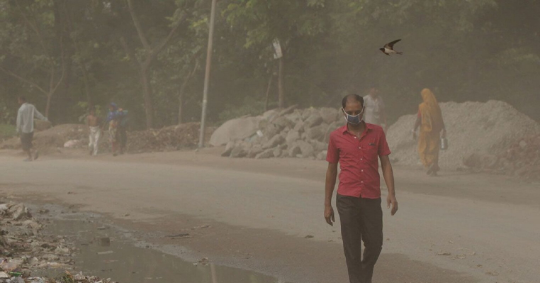Adverse Effects of Air Pollution in Bangladesh
Sabiha Akter Seema | 03 June 2021
The existence of pollutants in the environment that are hazardous to human and other living beings' health or that affect the climate is referred to as air pollution. Gases such as fossil fuels, carbon monoxide, sulphur dioxide, nitrous oxides, ammonia, methane, and chlorofluorocarbons are all examples of air pollutants. Such gases in the atmosphere can cause air pollution.
An example is the greenhouse gas name ozone which is a major pollutant in cities. Ozone has both positive and negative effects on our ecosystem. Some more sources of gases and particles that contribute to air pollution include vehicle exhaust, unplanned development and construction works, particulate matter, plastic wastes, brick kiln fumes, unhygienic condition of hospitals, ashes, flames and fires. Multiple brick kilns throughout the city produce massive amounts of dust and smoke. Pollution is exacerbated by garment factories, farms, and leather companies in and around the city and other industries on the periphery. Increased financial deepening is also responsible for air pollution. The solid and liquid substances contained in our air are termed aerosols. When we burn fossil fuels like coal and petroleum, and wood, we release aerosols into the atmosphere. Many of the airborne pollutants are directly emitted from these sources, while others are formed as a result of chemical processes.
The Health Effects Institute and the Institute for Health Metrics and Evaluation, both based in the United States, released a study titled "State of Global Air 2020" as part of the global burden of disease initiative. According to the study, Bangladesh is ranked ninth in the top ten countries with the highest levels of outdoor ambient particulate matter (PM 2.5). PM 2.5 is a tiny particle with a diameter of 2.5 micrometers or less and is formed by all forms of combustion found in both urban and rural areas. In Bangladesh, PM 2.5, which can penetrate deep into the respiratory tract and cause serious health problems, was responsible for 74,000 deaths. About 94,800 people died due to household air emissions from solid fuels, while the rest died from ozone exposure.
According to the World Air Quality Index (AQI) Report, the South Asian country was recently named the most polluted country, and Dhaka was ranked as the second most polluted city in the world. As a densely populated city, it is vulnerable to air pollution caused by the widespread use of automobiles, motorcycles, and trucks, many of which are not subject to strict regulations about the efficiency of their engines or the fuels they use. The metro rail projects have increased air pollution in Dhaka as well.
According to Salam, an air quality specialist, transport-related air pollution dropped by roughly 80 percent due to the COVID-19 pandemic until April last year. Once the countrywide lockdown was lifted, the situation began to deteriorate.
Bangladesh Environment Conservation Rules 1997 established standards for air quality and pollution. Other regulations, such as the Bangladesh Environment Conservation Act 1995 and the Brick Manufacturing and Brick Kilns Establishment (Control) Act 2013, aim to control air pollution. Clean air must be available to everybody, and government agencies must make no exceptions to safeguard citizens' right to clean air. Simultaneously, institutional frameworks should be strengthened, and necessary by-laws should be drafted to ensure the effective implementation of the Acts.
Air pollution can cause illnesses, wheezing, asthma, coughing, chest pain, headaches, upper respiratory infections and even death in humans. It can affect other living organisms, including livestock and food sources. It can also harm our environment through global warming and the resulting climate change, increased carbon dioxide and greenhouse gases, ozone layer depletion and habitat destruction such as land loss. Both human activities and natural processes can cause air pollution. A variety of pollution-related illnesses, such as cardiovascular disease, lung problems, stroke, and lung disease, are all linked to air pollution. Bad air quality has a wide range of health consequences for humans, but it primarily affects the respiratory and cardiovascular systems.
To enhance the air quality in Beijing while sustaining stable economic growth, China enforced pollution control measures, tighter enforcement, and better rules and regulations. Though China is the world's biggest emitter of greenhouse gases and is home to many of the world's most polluted cities, they are minimizing air pollution by implementing various environment-friendly strategies.
Environmental contamination is a chief concern for the majority of the world's developing countries. Both international and national law and regulation have been developed to limit the adverse effects of air pollution. Because of the threat of environmental pollution, countries and the general public have become increasingly aware of the environment we live in and the air we breathe. The government, governmental organisations and private sector should take proper actions for minimizing air pollution and environmental degradation by implementing necessary steps such as proper law enforcement, using alternative energy, conducting research, creating public awareness, promoting green entrepreneurship, initiating environmentally friendly services, stopping deforestation and afforesting. We also need to improve and modernize the urban traffic system and reduce coal, oil, and gas dependency. Clean Air Solutions is a collection of industrial air pollution abatement solutions for treating hazardous dust generated by various industrial processes. To become pioneers in the business transition to a green economy, innovative entrepreneurs must alter themselves to do more. Before relying on conventional energy, energy efficiency and renewable energy solutions should be investigated. If necessary, marginal lands should be reforested to offset carbon emissions.
Sabiha Akter Seema, Program Assistant, Centre for Governance (CGS).
Views in this article are author’s own and do not necessarily reflect CGS policy.
